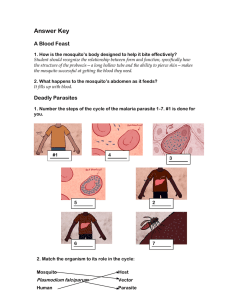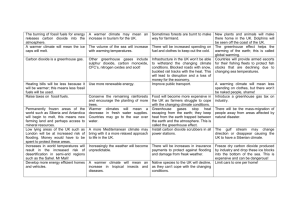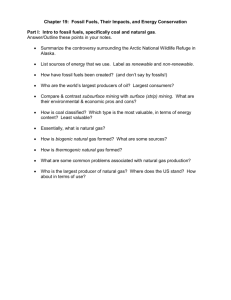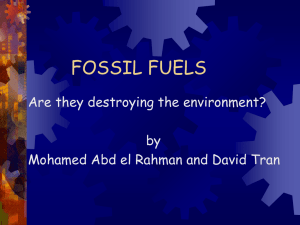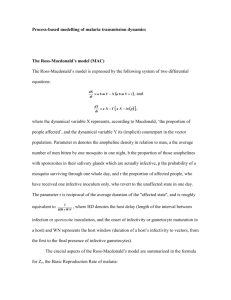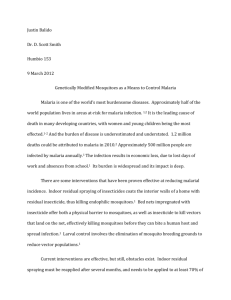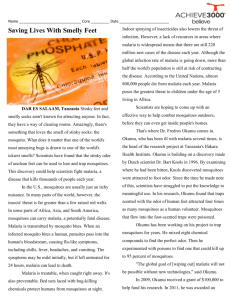Word - Changing the Balance
advertisement
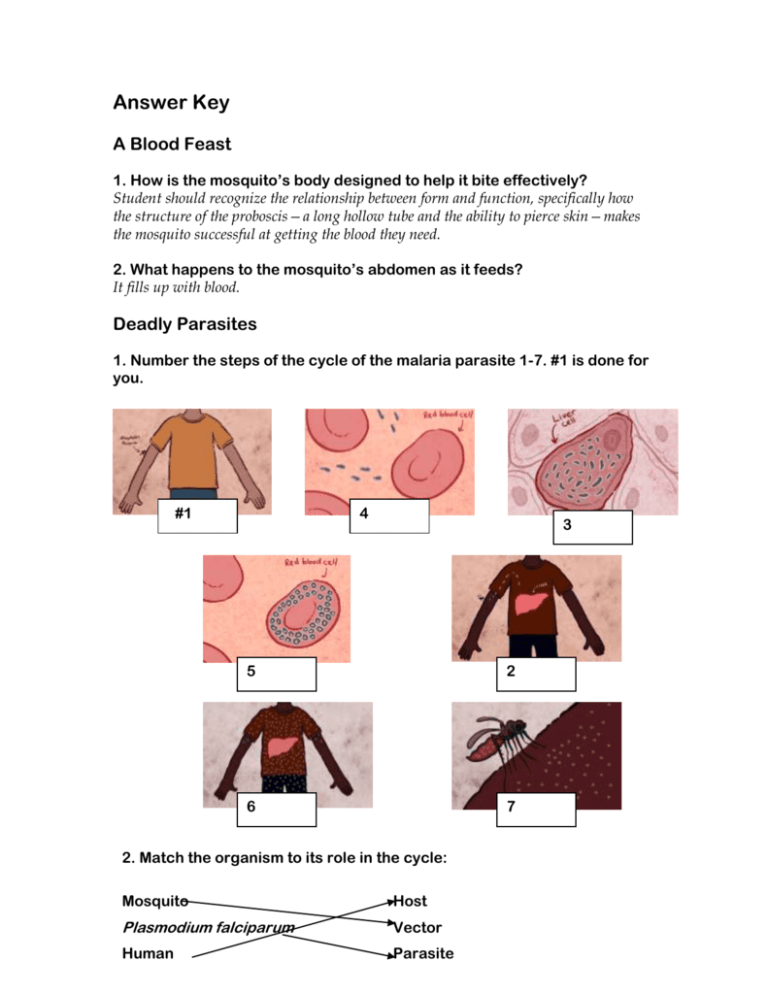
Answer Key A Blood Feast 1. How is the mosquito’s body designed to help it bite effectively? Student should recognize the relationship between form and function, specifically how the structure of the proboscis—a long hollow tube and the ability to pierce skin—makes the mosquito successful at getting the blood they need. 2. What happens to the mosquito’s abdomen as it feeds? It fills up with blood. Deadly Parasites 1. Number the steps of the cycle of the malaria parasite 1-7. #1 is done for you. #1 4 3 5 2 6 7 2. Match the organism to its role in the cycle: Mosquito Host Plasmodium falciparum Vector Human Parasite History of a Lethal Disease Read the following information. Studies have shown that animals and plants may move into new regions if the physical environment changes. The organisms can live in areas they could not live before. Mosquitoes that carry malaria are one example of this phenomenon. Answer the questions below. 1. Mosquitoes that carry malaria would be mostly likely to spread to a new area where: a. average temperatures increase over time b. temperatures fall quickly c. insecticide treated nets are used d. rainfall decreases in an area 2. People living where the malaria- carrying mosquitoes have recently moved differ from people in the areas where malaria has been common with people living in areas. As compared to people in areas where malaria carrying mosquitoes have always lived, people in areas where mosquitoes have recently moved a. don’t get as sick from malaria as others. b. get sick in greater numbers because they didn’t get the vaccine that others did. c. spend more time in their houses and so don’t get malaria d. get sick in greater numbers because they don’t have the immune protection of those who have been exposed for longer 3. Explain how chloroquinine affected the incidence of malaria. (Be sure to include the importance of the short life cycle of the Plasmodia) Initially chloroquinine was a very effective treatment against malaria—it was effective, inexpensive, and had few side effects. However, because Plasmodia have a very short life cycle, they change rapidly in response to their environment. They mutated so that most Plasmodia became resistant to chloroquinine—it no longer killed them. . Changing Climate/Changing Habitats The organisms discussed in the video are: Edith’s checkerspot butterfly Culex mosquitoes Anopholes mosquitoes Polar bears Choose one of the organisms and answer the following: 1. How is a changing climate affecting this organism? Butterfly; southern populations dying off Culex mosquito thriving in the American West Anopholes mosquito: moving into highland areas in Aftica that were once too cool for them Polar Bear: bear populations have been decreasing 2. Explain why a changing climate is having this effect. Butterfly needs a certain plant to develop from caterpillar to butterfly; plant stressed by climate changes, Culex mosquito: increased temperature and drought are causing population to spike because these mosquitoes thrive there. Anopholes mosquito: climate in highland areas is getting warm enough for the mosquitoes to survive Polar Bear: sea ice is disappearing (sea ice is crucial habitat for polar bears—for hunting and raising their young) 3. What are the potential consequences of the effect on this organism for other organisms (including human beings)? Butterfly; not specified. May talk about pollination or predators that depend on these species for food Culex mosquito; West Nile virus outbreaks are increasing Anopholes mosquito: brought malaria parasites to areas where people have not developed the immunity (as they had where the mosquitoes have been common for a long time) Polar Bear: extinction if forever; decline or extinction of a top predator species can upset the ecosystem in ways we can’t predict; indication of other serious consequences—including sea level rise. Tracking Temperature Trends Refer to the graph to answer the questions. 1. The concentration of CO2 in the earth’s atmosphere a. has decreased over the last 100 years b. decreased between 1880 and 1950, and has increased since then c. has increased at a steady rate over the last 100 years d. has increased rapidly over the last 50 years 2. The increase in global average temperatures since the second part of the 20th century: a. has been accompanied by an increase in the concentration of CO2 b. is the result of unreliable data gathered by a few people c. indicates there will soon be an Ice Age d. has been accompanied by decreases in rainfall and humidity The Carbon Cycle Match the parts of the carbon cycle with the pictures below. (Some statements may be used more than once). 1. Animals exhale carbon dioxide. 2. Carbon dioxide is taken up during the process of photosynthesis. 3. Decomposers re-use carbon from dead organisms. 4. Oceans and oil and coal deposits are carbon sinks. 5. Carbon dioxide is released into the atmosphere when fossil fuels are burned. ____4.___ __3_____ __5_____ _1______ __2_____ ____5___ ___4____ The Greenhouse Effect 1. How would increasing CO2 levels affect the Earth’s average temperature? a. Temperature would increase as the CO2 level increases. b. Temperature would decrease as the CO2 level increases. c. Earth’s average temperature would not change. d. Temperature would be lower than usual. 2. Circle all the ways that greenhouse gases (GHG) affect the energy radiating from the earth. a. GHG increase the amount of energy from the sun, and therefore increase the energy radiated by the earth b. GHG allow some energy to escape into space c. GHG reflect some energy back to the earth d. GHG decrease the amount of energy from the sun, and therefore decrease the energy radiated by the earth 3. If there were no greenhouse gases in the atmosphere a. it would be great for life on earth because there would be no worry about climate change b. the earth’s temperature wouldn’t change significantly c. the earth’s temperature would decrease significantly d. the earth’s temperature would increase significantly Molecules on the Move: Greenhouse Gases 1. What might happen to the energy from the earth when it strikes a molecule of CO2 in the atmosphere? The energy may escape into space, may be deflected back to earth, or deflected elsewhere in the atmosphere. 2. What might happen to the energy from the earth when it strikes a molecule of N2 in the atmosphere? The energy will escape into space. 3. Water vapor tends vibrates when struck by energy. Do you think that water vapor is a greenhouse gas? Why or why not? Water vapor is a greenhouse gas, it behaves much like carbon dioxide. In the interactive the CO2 vibrates and it is a greenhouse gas. (These molecules absorb heat energy causing vibration. Eventually the energy is released, going in any direction, and often being absorbed by another greenhouse gas—keeping the energy close to the surface of the earth.. Nitrogen gas, on the other hand, is more stable and doesn’t absorb energy—the waves continue in their original trajectory. The differences are related to the types of bonds in the molecules. For a complete explanation see http://www.windows2universe.org/earth/climate/cli_greengas.html ) Fossil Fuel and a Fiery Future 1. Why are coal, oil, and natural gas called “fossil fuels”? They are called fossil fuels because they are formed from organisms which died a long time ago—from fossils. Time, pressure and heat caused them to decompose into fossil fuels. 2. Fossil fuels have been around for millions of years, but it is only over the last few years that we have become concerned about their impact on the climate. a. When fossil fuels are buried what happens to the carbon? Nothing—it remains as a carbon sink b. When fossil fuels are burned what happens to the carbon? It combines with oxygen to form carbon dioxide and is released into the atmosphere and into the oceans. c. Explain how the carbon in the fossil fuels is related to the earth’s temperature. When the carbon in the fossil fuels is burned it goes from being in a sink—remaining in one place, to being carbon dioxide which is released. The carbon dioxide that is released into the atmosphere causes some of the heat usually radiated into space to be deflected back to the earth’s surface. That increases the earth’s temperature. 3. Which human activity would most likely result in increased CO2 emissions? Justify your answer. a. driving cars more often b. recycling more paper, cans, and bottles c. planting trees d. measuring the amount of oxygen in water . Driving cars burns fossil fuels which releases CO2 into the atmosphere. The other activities listed don’t have an effect on CO2 levels (recycling, although that can help the environment in other ways, and measuring the amount of oxygen), or help decrease them (planting trees). What We Do Now 1. Describe 3 human uses or behaviors that produce greenhouse gases. This can be any number of things: heating homes, driving cars, using any electricity, flying in a plane, etc. etc. 2. Describe 3 ways people can reduce the amount of greenhouse gases that are produced. This can also be any reasonable conservation measure—carpooling, riding bicycles, turning lights off, thermostats down, etc. etc. Encourage students to be specific.
